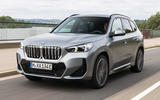If you’re hoping for echoes of the BMW i3’s art deco design and originality in the new BMW iX1, you’ll be disappointed.
Let’s face it, the iX1 is rather derivative-looking; as with the vast majority of its rivals, from the Audi Q4 e-tron to the Mercedes EQA and Lexus NX, it’s not ugly but it’s not pretty or even terribly memorable, either. Which is why we’ll actually start with the inside of the BMW iX1, because it’s here that it really makes an impact. Don’t worry, we’ll get to the 308bhp all-electric, four-wheel drive powertrain in just a moment.
First, check out the curved touchscreen; a focal point in an interior that feels every bit as plush and high-class as that of an X3, and is deliberately reminiscent of the BMW iX.
Complete with a 10.7-inch touchscreen and a 10.4-inch driver’s information screen, the operating system 8’s graphics are second to none. With wireless Apple CarPlay and Android Auto as standard on ever iX1, native features such as the excellent nav will be defunct for most. If you do use them, the configurable shortcut icons on the touchscreen’s home page will be useful.
Unfortunately, climate control is now done in-screen, but at least the controls are permanently visible and within easy reach, and the voice control is also one of the more reliable that we’ve tried.
Overall, the comfort, perceived quality and material finish of the iX1’s interior is really quite something. It needs to be to justify a price of more than £52,000, which is teeth-suckingly high yet is also roughly on a par with equivalent rivals like the Mercedes EQA, Audi Q4 e-tron and Volvo XC40.
It’s practical, too. The iX1 gets a useful 490 litre boot capacity and a cubby beneath the boot floor that’s big enough for a couple of cables, while the rear seats split and fold in a 40/20/40 format. The rear seatback also recline in a 60/40 split, but they don’t slide, as they do in the non plug-in X1 models that share this new ‘UKL’ platform.
In the iX1, the rear seats are fixed, and you also have a slightly higher floor in relation to the seat cushion, which can make rear passengers with longer legs feel like their knees are bent up a bit uncomfortably. Other than that, leg- and headroom are decent enough to make life easy for two adults sat on the rear bench.
As for how it drives? We spent time in a pre-production car around BMW’s factory in Regensburg, and we can confirm that the iX1 is properly fast. As you’d expect, given the dual electric motors – one on each axle – which manage a combined 364lb ft. Even without Sport mode engaged the iX1 is seriously punchy. Engage Boost mode, which you do by pulling the paddle on the wheel, and you get 10-seconds of comical acceleration.
Let’s face it, the Boost paddle is something of a gimmick, but it’s a fun one that can certainly help with the odd rapid overtake. If you do enjoy your weird gimmicks and electronica in modern cars, try the Energise mode.
This is found in the drive modes, and brings with it a colourful, artistic wallpaper across the screen and gently pulsing background noise that sounds like a muted, metronomic strimmer. Accelerate hard, and this suddenly morphs into what could be mistaken for an augmented elephant being tortured. Odd.




























Add your comment